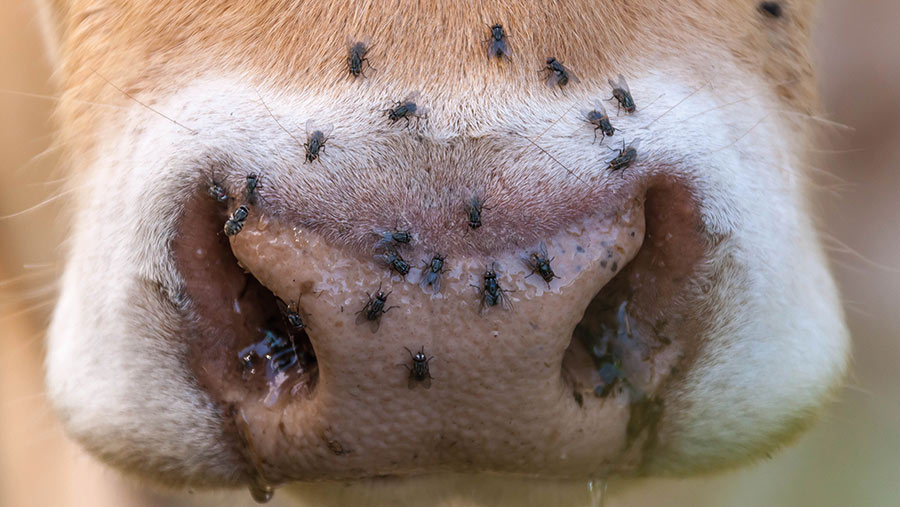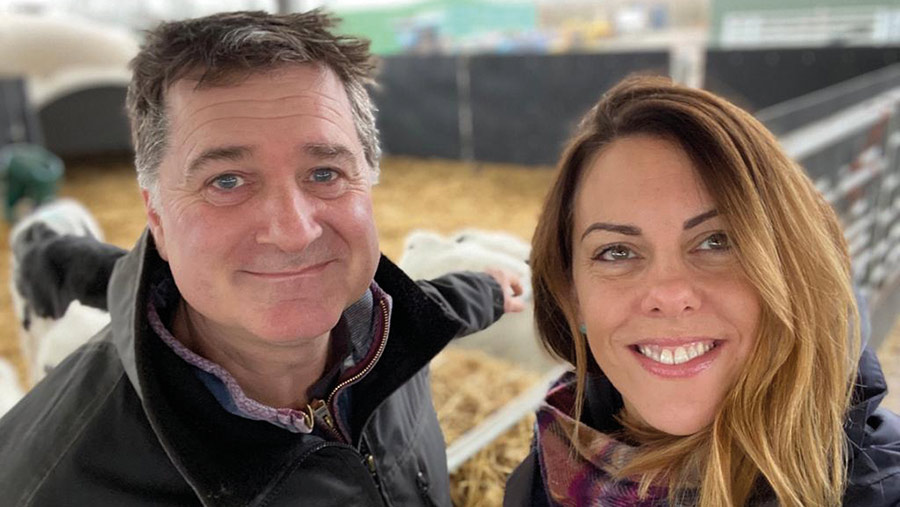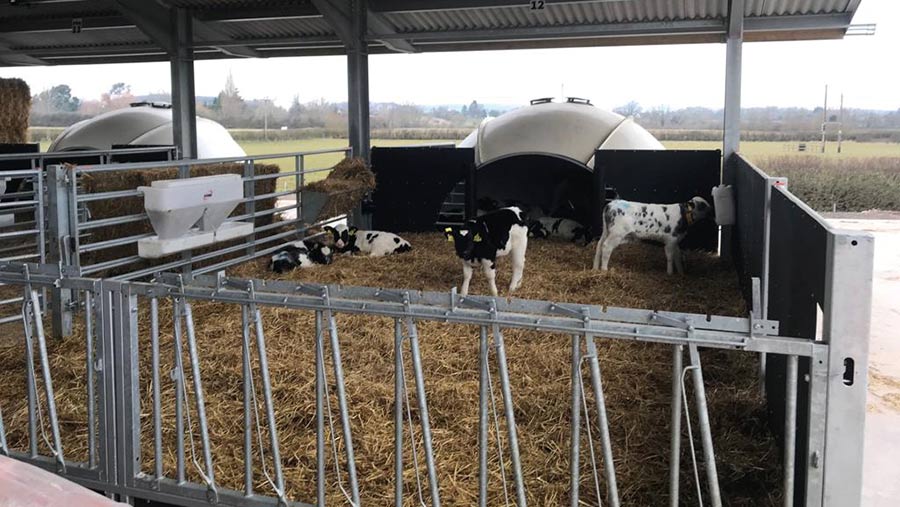How parasitic wasps cut calf unit chemical control by 30%
 © Tim Scrivener
© Tim Scrivener A contract calf-rearing business has cut its use of chemical fly treatments by nearly one-third since introducing parasitic wasp controls at a cost of 50p an animal.
The wasps are used to reduce populations of nuisance and biting flies at Cobblers Farm, Worcester, where fruit growers Rob and Hannah Collins diversified into contract calf rearing in 2018.
They have a throughput of 1,200 calves a year in an igloo system. In their first season of rearing, they encountered problems with high levels of flies, particularly when the weather was wet and warm.
See also: Collaborative calf-rearing venture brings multiple benefits
“We had an explosion of flies agitating the calves and it was a real issue, especially at the back end of the season when flies were biting harder,” says Mr Collins.
“Instead of having calves all lying down, chewing their cuds and basking in the sun, they were standing up and by the gates trying to get away from the flies. When they were doing that, they weren’t performing.”
Initially, a pour-on insecticide was used. The result was rapid, but the cycle soon started again.
Mr Collins was also concerned that applying treatments added another stressor to the animals during the nine weeks they were at the farm.
“There were already nine ‘stress events’ during those weeks, for instance, dehorning, vaccination, weaning and pre-movement TB testing, and these can all impact on performance. I didn’t want to introduce another,” he says.

Rob and Hannah Collins © Hannah Collins
Parasitic wasps
As a fruit grower, he was using biological techniques on his cherry crop, introducing bumblebees to pollinate the crop when it was too cold for honeybees.
He saw the potential for a similar approach in the calf environment, using parasitic wasps that actively seek out the pupae of nuisance flies.
A female wasp pierces a nuisance fly maggot pupae, laying up to 350 eggs. When new wasps hatch from the eggs, they eat the maggots, and then continue the cycle of predation.
“It made sense to have controls working in the background,” says Mr Collins.
A consultant from the supply company visited the farm for an initial assessment of the calf environment to work out where the pupae needed to be distributed.
The pupae are delivered in cartons, protected by sawdust, and Mr Collins sprinkles them in the areas recommended by the consultant, where the risk of trampling is low.
“We then just leave the wasps to do their work,” he says.

© Rob Collins
Measuring success
In the first season of using natural fly controls there was limited success.
The Collinses had been warned it would take time to build up populations, so this did not come as a surprise. By the second season they were seeing a big drop off in fly numbers.
The first batch of pupae of the season are released in mid-March and every six weeks thereafter, until the end of August.
“We used higher rates in the first season to build up the population, but for every season after that they have been at a lower level, with each six-week application the same,” says Mr Collins.
Cost
The business spends £600 a year on parasitic control. Use of pour-on treatments, which previously cost around 30p a dose, has been cut by 30%.
“We still use these when we feel that the adult fly population is high, but we don’t want their use to be routine,” he says.
He had concerns about how the life cycle of the wasps would be impacted when the calf pens were mucked out. However, by relocating the wasps to the muck heaps they could continue working, helping to minimise fly populations in general.
Natural fly controls aren’t completely failsafe, he admits.
“We came unstuck last season,” he says. “For most of the summer we had practically zero flies, probably around 5% compared with the numbers in 2018. But that meant that there were only low levels of fly larvae for the wasps to feed on.
“At the end of September, we had a very warm spell of weather and fly numbers exploded, and the wasps couldn’t keep pace with the flies due to the lower temperatures.”
He intervened with a pour-on treatment for the calves, but says it was at least three weeks before the situation improved.
Mr Collins’ total spend on all fly controls is around £1.50 a calf, including labour. But he says it means an additional 2-3kg in growth over the nine-week rearing period.
“The principle we operate to within all our businesses is to capture single-digit percentage performance improvements, and for our calves that means controlling the flies that hinder their growth potential.”
Factors to consider when using biological controls
Vet Mark Hickinson works with multiple dairy farmer clients using biological and physical fly control techniques. These vary from smaller scale organic systems to large-scale intensive housed herds.
Farm system type is a key consideration in deciding which fly control strategies are appropriate.
“Strategies to control flies on an extensive sheep farm would differ dramatically from an indoor dairy unit,” says Dr Hickinson, of the Sandstone Vet Group.
“Successful control is reliant on tailor-made programmes for each individual farm.”
Another critical factor is to work out where flies are breeding – typically in areas where dung and used bedding accumulate. Removal of these breeding grounds will have a major impact on the nuisance fly population.
Timing is also important – fly populations increase exponentially over the season. A single fly that appears early in the season can lead to many hundreds of thousands later in the season. Removing breeders early has a huge impact on subsequent fly numbers, says Dr Hickinson.
He warns against expecting immediate results because the effects of biological control build over time. “Typically, modest gains are made in the first season, however, in subsequent years, this is built on significantly.
“The farmers that give up in the first year are those that expect to see an instant hit, so it’s critical to manage short-term expectations.”
Dr Hickinson advises that natural fly controls are more successful when used as a preventative rather than a cure for a mid- or late-season surge in fly numbers.
“It is no good having billions of flies in August and expecting biological controls introduced then to solve the problem overnight,” he cautions.
On the farms where he works, he implements controls throughout the fly season, generally starting in April and continuing to the end of October.
“At the end of the season we are not only chasing current populations of flies, but the following year’s breeders,” he says.
Farmers are also warned against expecting natural controls to be a money saver, at least in terms of purchasing the control tools. However, the use of chemical treatments can be significantly reduced, Dr Hickinson suggests.
The main financial benefit is achieved by reducing the impact of flies on the herd. Fly worry can result in reduced milk yields, and preventing infections caused by flies, such as mastitis, can lead to reduced antibiotics usage.
“Comfort in the parlour for both cows and people cannot be overestimated,” Dr Hickinson adds.
